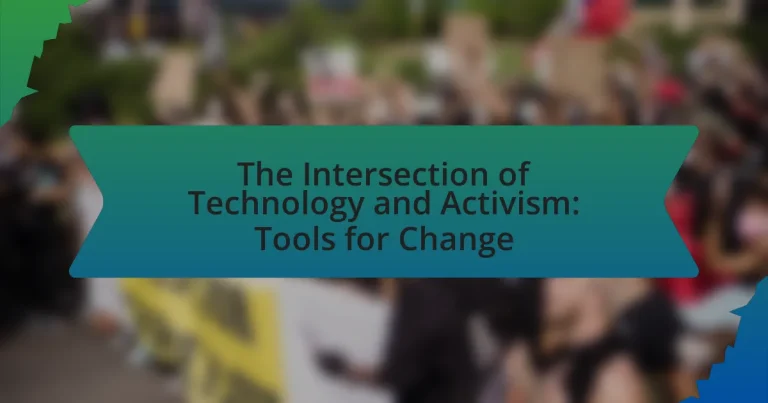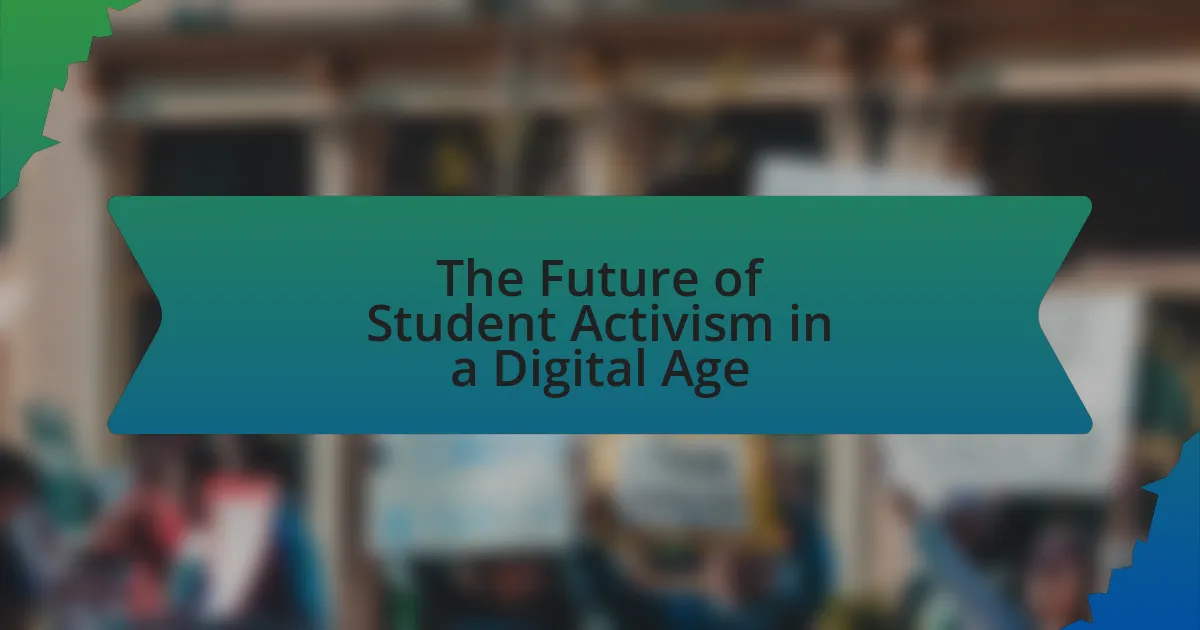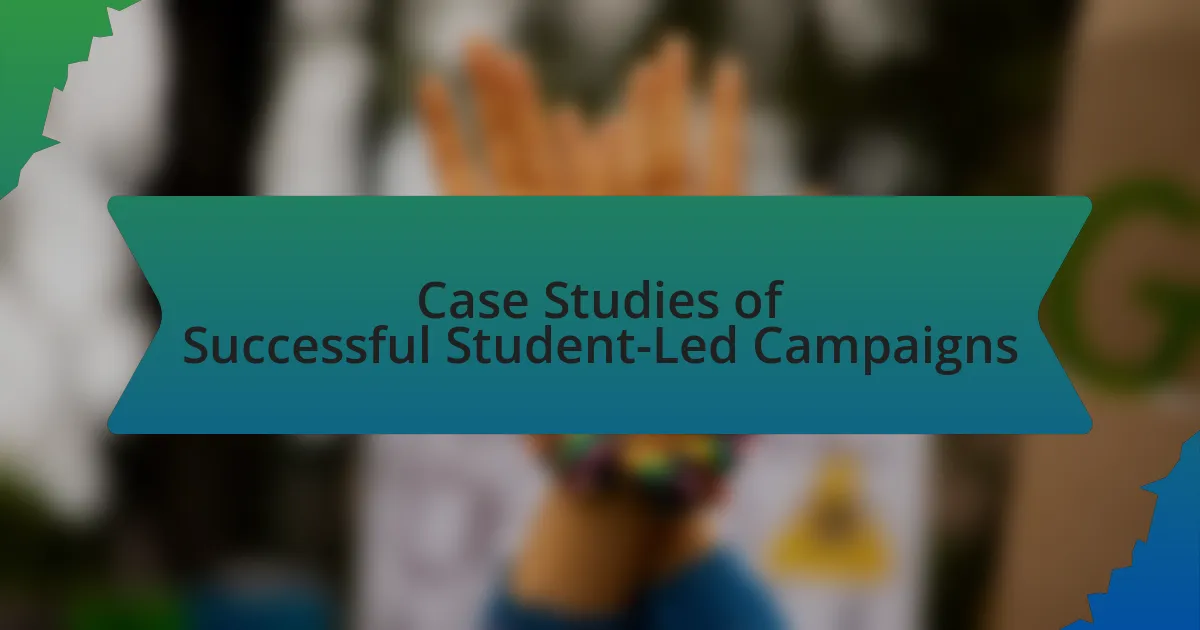The article explores the intersection of technology and activism, highlighting how technological tools and platforms are utilized to promote social change and advocate for various causes. It examines the influence of social media, mobile applications, and data analytics on modern activism, showcasing key advancements that enhance communication, mobilization, and awareness. The article also discusses the role of technology in empowering marginalized communities, the challenges activists face, and the best practices for leveraging digital tools effectively. Additionally, it addresses the implications of government surveillance and the importance of digital security for activists in their efforts to drive social change.
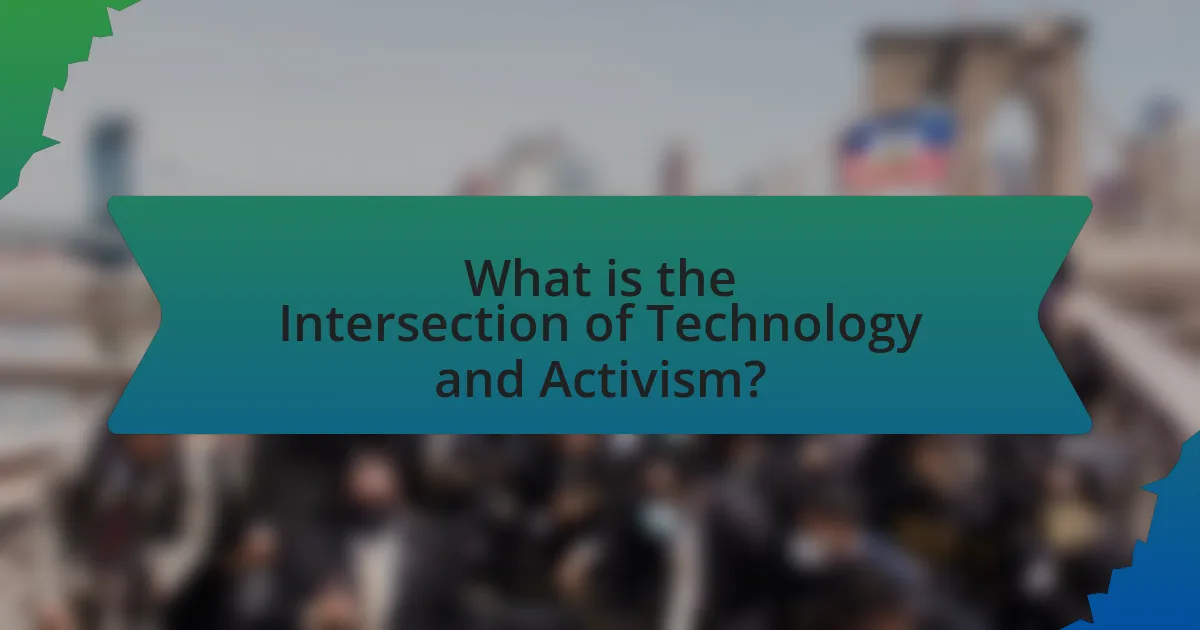
What is the Intersection of Technology and Activism?
The intersection of technology and activism refers to the ways in which technological tools and platforms are utilized to promote social change and advocate for various causes. Activists leverage social media, mobile applications, and data analytics to organize movements, raise awareness, and mobilize supporters. For instance, the Arab Spring in 2011 demonstrated how social media platforms like Twitter and Facebook facilitated communication and coordination among protesters, leading to significant political changes in several countries. This synergy between technology and activism enhances the reach and impact of social movements, enabling real-time communication and broader engagement with global audiences.
How has technology influenced modern activism?
Technology has significantly influenced modern activism by enhancing communication, mobilization, and awareness. Social media platforms like Twitter and Facebook enable activists to reach a global audience instantly, facilitating the rapid spread of information and organizing protests. For instance, the Arab Spring in 2011 showcased how platforms like Facebook were instrumental in mobilizing protests across multiple countries, leading to significant political changes. Additionally, technology provides tools for fundraising and resource sharing, exemplified by crowdfunding platforms that support various causes. According to a 2020 report by the Pew Research Center, 69% of Americans believe social media is an effective tool for activism, highlighting its role in shaping public discourse and engagement.
What are the key technological advancements that have shaped activism?
Key technological advancements that have shaped activism include social media platforms, mobile communication, and data analytics. Social media platforms like Twitter and Facebook have enabled rapid information dissemination and mobilization of supporters, exemplified by movements such as the Arab Spring in 2011, where social media played a crucial role in organizing protests. Mobile communication has facilitated real-time coordination and support among activists, allowing for immediate updates and responses during events. Data analytics tools have empowered activists to analyze trends, target audiences, and measure the impact of their campaigns, enhancing strategic planning and outreach efforts. These advancements collectively have transformed how activism is conducted, making it more accessible and effective.
How do social media platforms facilitate activist movements?
Social media platforms facilitate activist movements by providing a space for rapid information dissemination and community building. These platforms enable activists to share messages, organize events, and mobilize supporters quickly, often reaching a global audience. For instance, during the Arab Spring, social media was instrumental in coordinating protests and sharing real-time updates, which significantly contributed to the movements’ visibility and impact. Research indicates that social media can increase engagement and participation in activism, as seen in studies showing that campaigns like #BlackLivesMatter gained momentum through widespread sharing and interaction on platforms like Twitter and Facebook.
Why is the intersection of technology and activism important?
The intersection of technology and activism is important because it enhances the effectiveness and reach of social movements. Technology provides activists with tools for communication, organization, and mobilization, enabling them to disseminate information rapidly and engage a global audience. For instance, social media platforms have been pivotal in movements like the Arab Spring, where they facilitated real-time sharing of events and coordinated protests, demonstrating how technology can amplify activist efforts. Additionally, data analytics and digital tools allow for better understanding of social issues, helping activists to strategize and target their initiatives more effectively.
What role does technology play in raising awareness for social issues?
Technology plays a crucial role in raising awareness for social issues by facilitating rapid information dissemination and enabling global connectivity. Social media platforms, for instance, allow activists to share messages and mobilize support instantly, reaching millions of users worldwide. According to a 2020 Pew Research Center study, 69% of adults in the U.S. use social media, making it a powerful tool for spreading awareness and fostering community engagement around social causes. Additionally, technology enables the creation of online petitions and crowdfunding campaigns, which have proven effective in rallying resources and support for various social movements, such as the Black Lives Matter movement, which gained significant traction through platforms like Twitter and Instagram.
How does technology empower marginalized communities?
Technology empowers marginalized communities by providing access to information, resources, and platforms for advocacy. For instance, mobile technology enables individuals in remote areas to connect with essential services, such as healthcare and education, which were previously inaccessible. According to a report by the International Telecommunication Union, increased internet access can lead to a 1.38% increase in GDP per capita, demonstrating the economic benefits of technology for these communities. Additionally, social media platforms allow marginalized groups to amplify their voices, organize movements, and raise awareness about social injustices, as seen in movements like #BlackLivesMatter and #MeToo. These platforms facilitate community building and mobilization, empowering individuals to advocate for their rights and influence policy changes.
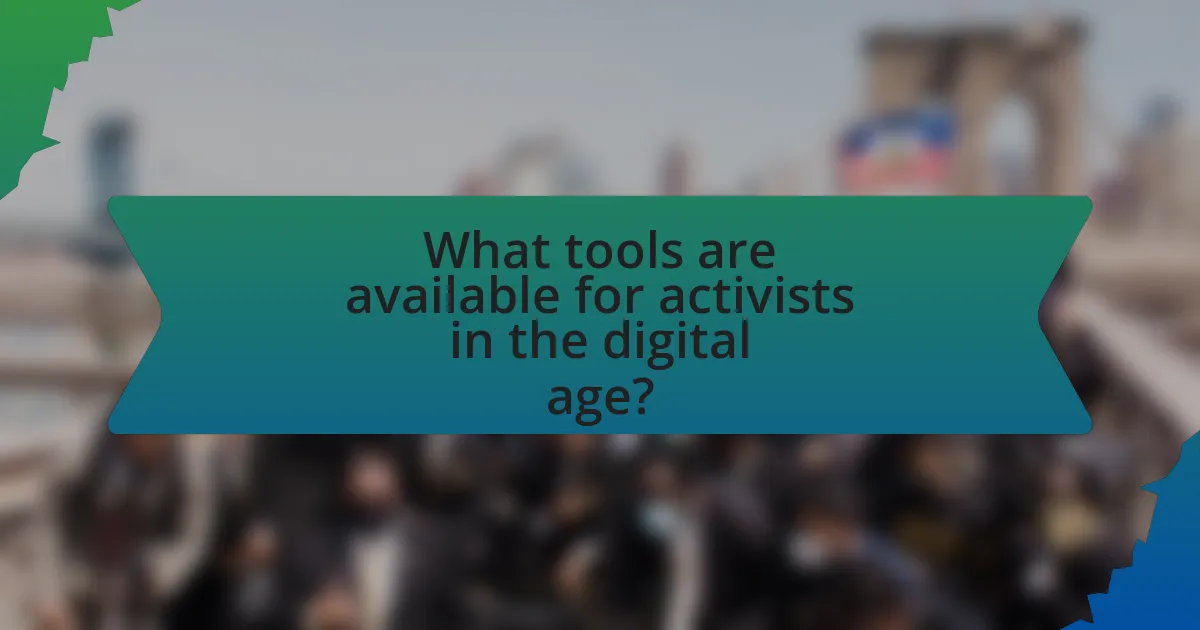
What tools are available for activists in the digital age?
Activists in the digital age have access to various tools that enhance their ability to organize, communicate, and mobilize. Social media platforms like Twitter and Facebook enable real-time communication and widespread dissemination of information, allowing activists to reach large audiences quickly. Additionally, encrypted messaging apps such as Signal and Telegram provide secure communication channels, protecting sensitive discussions from surveillance.
Online petition platforms like Change.org facilitate grassroots mobilization by allowing individuals to gather support for causes easily. Crowdfunding sites such as GoFundMe enable activists to raise funds for their initiatives, while data visualization tools like Tableau help present complex information in an accessible format, making it easier to advocate for change.
Furthermore, digital mapping tools like Ushahidi allow activists to document and visualize incidents of injustice, enhancing awareness and accountability. These tools collectively empower activists to leverage technology effectively in their efforts for social change.
What are the most effective digital tools for organizing protests?
The most effective digital tools for organizing protests include social media platforms, messaging apps, and event management software. Social media platforms like Twitter and Facebook facilitate rapid information dissemination and community engagement, allowing organizers to reach large audiences quickly. Messaging apps such as WhatsApp and Signal enable secure communication among organizers and participants, ensuring coordination without surveillance risks. Event management software like Eventbrite helps in planning logistics, managing registrations, and tracking attendance. These tools have been proven effective in various movements, such as the Arab Spring, where social media played a crucial role in mobilizing protests and sharing real-time updates.
How do mobile apps enhance grassroots organizing?
Mobile apps enhance grassroots organizing by facilitating real-time communication and coordination among activists. These applications enable users to share information quickly, mobilize supporters, and organize events efficiently, which is crucial for grassroots movements that often rely on rapid responses to emerging issues. For instance, platforms like Signal and WhatsApp allow for secure messaging, while event management apps like Eventbrite help in organizing rallies and meetings. According to a study by the Pew Research Center, 72% of smartphone users have engaged in civic activities through their devices, demonstrating the significant role mobile technology plays in empowering grassroots efforts.
What platforms are best for fundraising and resource sharing?
The best platforms for fundraising and resource sharing include GoFundMe, Kickstarter, and Indiegogo. GoFundMe is widely recognized for personal fundraising efforts, allowing individuals to raise money for various causes, with over $9 billion raised since its inception. Kickstarter focuses on creative projects, enabling entrepreneurs to secure funding through pre-orders, with over 18 million backers contributing more than $5 billion. Indiegogo offers flexible funding options for both personal and business projects, having raised over $1.5 billion across various campaigns. These platforms effectively facilitate fundraising and resource sharing by leveraging social networks and providing user-friendly interfaces for campaign management.
How can technology improve communication among activists?
Technology can improve communication among activists by providing instant access to information and facilitating real-time collaboration. Digital platforms like social media enable activists to share updates, mobilize supporters, and coordinate actions quickly, which is crucial during time-sensitive campaigns. For instance, during the Arab Spring, social media played a pivotal role in organizing protests and disseminating information, demonstrating how technology can amplify activist voices and enhance collective action. Additionally, encrypted messaging apps ensure secure communication, protecting activists from surveillance and repression, thereby fostering a safer environment for dialogue and strategy development.
What are the benefits of using encrypted messaging apps?
Encrypted messaging apps provide enhanced privacy and security for users’ communications. These apps utilize end-to-end encryption, ensuring that only the sender and recipient can read the messages, effectively preventing unauthorized access by third parties, including hackers and government surveillance. For instance, a report by the Electronic Frontier Foundation highlights that apps like Signal and WhatsApp employ strong encryption protocols, making it significantly more difficult for adversaries to intercept and decipher messages. This level of security is crucial for activists and individuals in oppressive regimes, where the risk of persecution for expressing dissenting views is high.
How do online forums and communities support activist efforts?
Online forums and communities support activist efforts by providing platforms for information sharing, mobilization, and collaboration among like-minded individuals. These digital spaces facilitate the dissemination of critical information, enabling activists to organize events, share resources, and raise awareness about social issues. For instance, during the Arab Spring, social media platforms and online forums played a crucial role in coordinating protests and spreading messages, demonstrating their effectiveness in real-time mobilization. Additionally, studies show that online communities can enhance collective identity and solidarity among activists, which is essential for sustaining long-term movements.
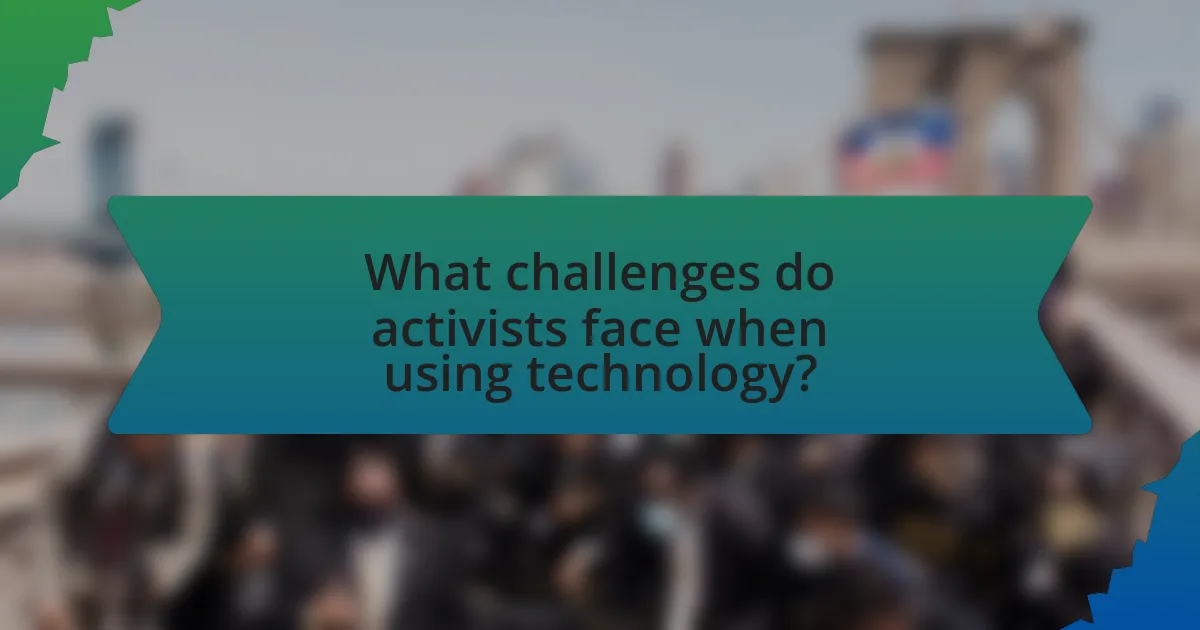
What challenges do activists face when using technology?
Activists face significant challenges when using technology, including surveillance, misinformation, and digital security threats. Surveillance by governments and corporations can lead to the monitoring of activists’ online activities, which may deter participation and compromise safety. Misinformation campaigns can undermine the credibility of activist movements, as false narratives spread rapidly through social media platforms. Additionally, digital security threats, such as hacking and data breaches, pose risks to sensitive information and personal safety, making it difficult for activists to organize and communicate effectively. These challenges highlight the complex relationship between technology and activism, where the same tools that empower movements can also expose them to significant risks.
What are the risks associated with digital activism?
Digital activism carries several risks, including surveillance, misinformation, and backlash from authorities. Activists often face increased scrutiny from governments and corporations, leading to potential legal repercussions or harassment. For instance, a report by the Electronic Frontier Foundation highlights that digital activists are frequently targeted by state surveillance, which can compromise their safety and privacy. Additionally, the spread of misinformation can undermine campaigns, as seen in various social media movements where false narratives have derailed genuine efforts. Lastly, backlash can manifest in the form of online harassment or physical threats, as evidenced by numerous cases where activists have been doxxed or faced violence due to their online presence.
How can activists protect their privacy and security online?
Activists can protect their privacy and security online by using encrypted communication tools, employing strong passwords, and utilizing virtual private networks (VPNs). Encrypted communication tools, such as Signal or WhatsApp, ensure that messages are secure and private, making it difficult for unauthorized parties to access conversations. Strong passwords, combined with two-factor authentication, significantly reduce the risk of unauthorized account access. VPNs mask the user’s IP address and encrypt internet traffic, providing an additional layer of security against surveillance and tracking. These methods are supported by cybersecurity experts who emphasize the importance of digital hygiene for individuals engaged in activism, as highlighted in reports from organizations like the Electronic Frontier Foundation.
What are the implications of government surveillance on activist movements?
Government surveillance significantly undermines activist movements by instilling fear and inhibiting free expression. When activists know they are being monitored, they may self-censor their speech and actions, leading to reduced participation and diminished effectiveness of their campaigns. Historical evidence, such as the FBI’s COINTELPRO program, illustrates how surveillance tactics were used to disrupt civil rights movements in the 1960s, resulting in a chilling effect on activism. Furthermore, studies indicate that surveillance can lead to increased distrust among activists, fragmenting movements and weakening collective action.
How can activists overcome technological barriers?
Activists can overcome technological barriers by leveraging accessible digital tools and fostering community collaboration. Utilizing platforms like social media, activists can disseminate information widely and mobilize support quickly, as evidenced by the success of movements such as the Arab Spring, where social media played a crucial role in organizing protests. Additionally, training programs and workshops can enhance digital literacy among activists, enabling them to navigate and utilize technology effectively. Research indicates that communities with higher digital literacy are more successful in advocacy efforts, demonstrating the importance of education in overcoming these barriers.
What strategies can be employed to ensure digital inclusivity?
To ensure digital inclusivity, organizations can implement strategies such as providing accessible technology, offering digital literacy training, and creating inclusive content. Accessible technology includes designing websites and applications that comply with accessibility standards, ensuring that individuals with disabilities can navigate and utilize digital platforms effectively. Digital literacy training equips marginalized communities with the skills needed to engage with technology, thereby reducing the digital divide; for instance, programs like the National Digital Inclusion Alliance have shown that targeted training can significantly improve digital skills among underserved populations. Additionally, creating inclusive content involves using language and imagery that reflects diverse communities, which fosters a sense of belonging and encourages broader participation in digital spaces.
How can activists leverage technology to reach wider audiences?
Activists can leverage technology to reach wider audiences by utilizing social media platforms, online petitions, and digital storytelling. Social media platforms like Twitter, Facebook, and Instagram allow activists to share their messages rapidly and engage with a global audience; for instance, the #BlackLivesMatter movement gained significant traction through Twitter, reaching millions and influencing public discourse. Online petitions, such as those hosted on Change.org, enable activists to gather support and demonstrate public backing for their causes, often leading to tangible policy changes. Additionally, digital storytelling through blogs, videos, and podcasts allows activists to convey personal narratives and foster emotional connections, enhancing audience engagement and mobilization. These methods collectively expand the reach and impact of activism in the digital age.
What best practices should activists follow when using technology?
Activists should prioritize digital security, effective communication, and strategic use of social media when using technology. Digital security practices include using strong passwords, enabling two-factor authentication, and employing encryption tools to protect sensitive information. Effective communication involves utilizing secure messaging apps and ensuring that information shared is accurate and verified to prevent misinformation. Additionally, activists should strategically use social media platforms to amplify their message, engage with supporters, and mobilize actions, while being mindful of privacy settings and the potential for surveillance. These practices are essential for maintaining safety and enhancing the impact of activism in the digital age.
How can activists effectively use social media for advocacy?
Activists can effectively use social media for advocacy by creating engaging content that resonates with their audience and encourages action. This involves utilizing platforms like Twitter, Facebook, and Instagram to share compelling stories, visuals, and calls to action that highlight their cause. For instance, the Ice Bucket Challenge in 2014 raised over $115 million for ALS research through viral social media engagement, demonstrating the power of well-crafted campaigns. Additionally, activists should leverage hashtags to increase visibility and connect with broader movements, as seen with the #BlackLivesMatter campaign, which mobilized global support and awareness. By analyzing engagement metrics, activists can refine their strategies to maximize impact and reach.
What are the key considerations for creating impactful digital campaigns?
Key considerations for creating impactful digital campaigns include understanding the target audience, crafting a clear and compelling message, utilizing appropriate channels, and measuring effectiveness. Understanding the target audience ensures that the campaign resonates with their values and needs, which is crucial for engagement. A clear and compelling message captures attention and drives action, while selecting appropriate channels maximizes reach and effectiveness. Finally, measuring effectiveness through analytics allows for adjustments and improvements, ensuring the campaign achieves its goals. For instance, a study by the Pew Research Center found that campaigns tailored to specific demographics significantly increase engagement rates, highlighting the importance of audience understanding.
